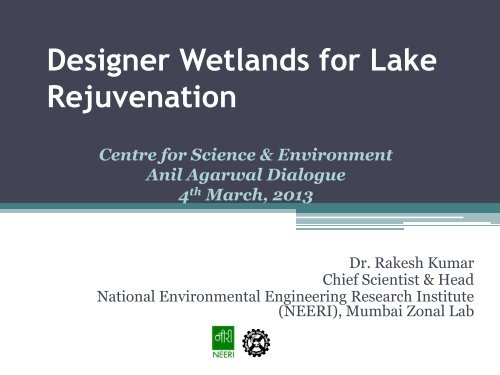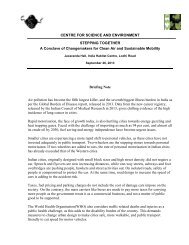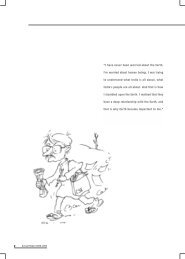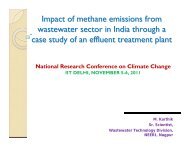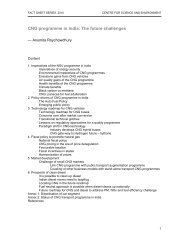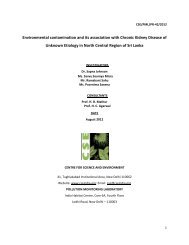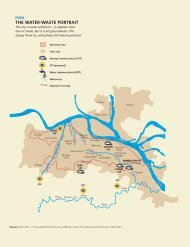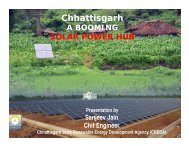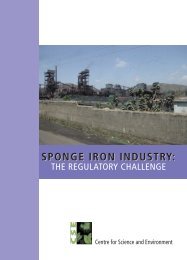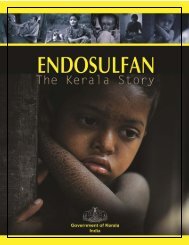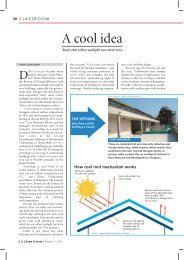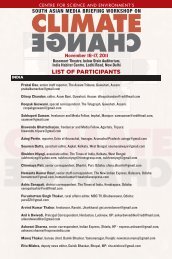Lake Rejuvenation - Centre for Science and Environment
Lake Rejuvenation - Centre for Science and Environment
Lake Rejuvenation - Centre for Science and Environment
Create successful ePaper yourself
Turn your PDF publications into a flip-book with our unique Google optimized e-Paper software.
Designer Wetl<strong>and</strong>s <strong>for</strong> <strong>Lake</strong><br />
<strong>Rejuvenation</strong><br />
<strong>Centre</strong> <strong>for</strong> <strong>Science</strong> & <strong>Environment</strong><br />
Anil Agarwal Dialogue<br />
4 th March, 2013<br />
Dr. Rakesh Kumar<br />
Chief Scientist & Head<br />
National <strong>Environment</strong>al Engineering Research Institute<br />
(NEERI), Mumbai Zonal Lab
Stabilize Climate<br />
Religious &<br />
Cultural<br />
Significance<br />
<strong>Lake</strong> Ecosystems - Life-savers <strong>for</strong><br />
Sediment<br />
Retention<br />
Prevent Floods<br />
Groundwater<br />
Recharge<br />
Urban Regions<br />
Recreational<br />
Activities<br />
Nutrient Sinks<br />
Aesthetically Pleasing<br />
Rich in resources<br />
like water, fish,<br />
aquatic flora<br />
Water Filtration
Urban <strong>Lake</strong>s: Under Constant Threat<br />
• Degradation of quality –<br />
▫ Untreated sewage discharge<br />
▫ Solid waste disposal<br />
▫ Eutrophication<br />
▫ Floating Vegetation<br />
• Degradation of quantity –<br />
▫ Abstraction of Water <strong>for</strong> variety of uses<br />
▫ Encroachment<br />
▫ Drainage & Alternate L<strong>and</strong> Use<br />
▫ Silt influx from degradation of catchment area
Water Bodies of New Delhi – Current<br />
Status
Degraded Water Quality<br />
Name of the Place pH DO COD TSS<br />
Deram<strong>and</strong>i 7 3.2 230.4 160<br />
Goyla Khurd 10 - 12 3.5 307.2 70<br />
Narayana 10 0 1945.6 1184<br />
Bamnouli A 9 - 10 0 358.4 114<br />
Bamnauli B 7 2.6 384 56<br />
Daulatpur 9 - 10 2.8 153.6 32<br />
Hastshal 9—10 0 204.8 92<br />
Hiran Kudna A 8-9 4.8 153.6 40<br />
Hiran Kudna B 10-10.5 3.5 128 54<br />
Kamruddin Nagar 7 to 8 1.2 204.8 100<br />
Kharkhari Nahar 10 to 10.5 1 76.8 22<br />
Khara Dabar 10 3.4 76.8 30<br />
Neelwal 10 4.5 409.6 56<br />
Limited data through grab sampling: Preliminary results
Receding Groundwater: The Harsh<br />
Reality in New Delhi<br />
The depth to water in the Delhi state varies greatly from 1.2 meter<br />
(in the Yamuna flood plain) to more than 64 meters (in the<br />
southern part of the Delhi Ridge) below ground level.<br />
The groundwater is declining in majority of the areas of Delhi on account<br />
of overexploitation of the resources. The rate of decline is as high as 1.7<br />
to 2 meters/year in some areas (South & South west Dist.).<br />
Seven out of nine districts of Delhi are categorized as overexploited<br />
with respect to dynamic groundwater resources.<br />
Source: http://cgwb.gov.in/documents/papers/incidpapers/paper%2015-%20kaushik.pdf
Groundwater Recharge: <strong>Lake</strong>s do Help!
Improving <strong>Lake</strong> Water Quality – No One-Step<br />
Solution, No Short-cuts..<br />
Ef<strong>for</strong>ts<br />
(concentrated<br />
& regular)<br />
Stakeholders (lake<br />
dependent<br />
communities,<br />
environmentalists<br />
& government)<br />
A Perennially Clear <strong>and</strong> Deep <strong>Lake</strong><br />
Methods (<br />
physical, chemical<br />
<strong>and</strong> biological) = A<br />
perennially clear<br />
<strong>and</strong> deep lake
Qualities of a Healthy <strong>Lake</strong>..<br />
High Water Clarity<br />
No Stench<br />
No Floating Vegetation<br />
No Floating Solid Waste<br />
High Dissolved Oxygen (D. O.)<br />
High Biodiversity
Prevent – Prevention is Better than<br />
Cure!<br />
• Prevent –<br />
Municipal <strong>and</strong>/or Industrial Effluent disposal<br />
Solid waste disposal<br />
Idol Immersion<br />
Introduction of exotic <strong>and</strong>/or invasive species<br />
Encroachments<br />
Over-exploitation of resources like fish, water<br />
Catchment Area degradation<br />
Slope Instability
Eutrophication<br />
Floating Treatment<br />
Wetl<strong>and</strong>s<br />
Cure is Necessary..<br />
Floating<br />
Vegetation<br />
Removal<br />
Brine Spray<br />
Physical Removal<br />
Introduction of<br />
biological predator<br />
(insects, fungi,<br />
herbivorous fish)
Sedimentation<br />
Dredging: When<br />
<strong>and</strong> Where??<br />
Low D.O.<br />
Does Aeration<br />
always Help??
A Healthy Ecosystem in the <strong>Lake</strong> = A<br />
Healthy A <strong>Lake</strong>
Rejuvenate <strong>Lake</strong>s..No more a Luxury,<br />
but a Necessity<br />
• The Shahadara <strong>Lake</strong> Project:<br />
The 35 acre Shahadara <strong>Lake</strong> region – once a lake,<br />
now no more…<br />
Drains carrying rainwater run-off clogged by<br />
building activities<br />
Rainfall in Delhi region not enough to charge a<br />
lake all by itself
NEERI’s Phytorid Technology (IP)<br />
Use of plant species along with their root<br />
system along with the natural attenuation<br />
processes can be combined together to get<br />
the Phytorid Technology.<br />
It is one such technological solution, which<br />
can be easily implemented in cities as well<br />
as in rural areas <strong>for</strong> treatment of<br />
wastewater.<br />
The system is based on use of specific<br />
plants normally found in natural<br />
environment with filtration <strong>and</strong> treatment<br />
capability.
On<br />
World <strong>Environment</strong> Day<br />
5th June, 2006<br />
at<br />
Kalina Campus<br />
Mumbai University<br />
Inaugurated by<br />
Shri Suresh Shetty<br />
(Honbl’e State Minister)<br />
Medical Education Higher & Technical Education<br />
18
SIEMENS: 5 lakh liter/day<br />
19
SIEMENS: Payback in 2<br />
years<br />
20
MAHINDRA , Igatpuri, Chakan<br />
21
Groundwater Recharge: <strong>Lake</strong>s do Help!
The Shahadara <strong>Lake</strong> <strong>Rejuvenation</strong><br />
Project<br />
Sewage Water will<br />
be treated by the<br />
“Phytorid<br />
Technology” based<br />
on constructed<br />
wetl<strong>and</strong> <strong>and</strong> will be<br />
used <strong>for</strong><br />
Rejuvenating the<br />
lake in the<br />
Shahadara locality<br />
of East Delhi
Floating Treatment Wetl<strong>and</strong>
Advantages..<br />
• Low Cost<br />
• No Power Requirement<br />
• Low on maintenance<br />
• Eco-friendly
Some Work of NEERI’s<br />
Technology <strong>for</strong> <strong>Lake</strong>s <strong>and</strong><br />
Nalla Waste Water Treatment
<strong>Lake</strong> Area: 11 Hector<br />
Phytorid Capacity 2 MLD<br />
Proposed to develop 3<br />
plant at periphery<br />
Telib<strong>and</strong>ha <strong>Lake</strong>,<br />
Raipur
Lonar <strong>Lake</strong><br />
<strong>Lake</strong> Area: 3 Ha<br />
Phytorid Capacity 500 KLD<br />
Plant Construction completed<br />
under commissioning<br />
Will Treat entire Sewage from<br />
Lonar City<br />
Nabi <strong>Lake</strong><br />
Under Consideration<br />
Lonar <strong>Lake</strong> (under<br />
threat), Maharashtra<br />
Phytorid Plant on Nabi <strong>Lake</strong>
Kot <strong>Lake</strong> Brahmapuri, Maharashtra<br />
Phytorid Capacity 450KLD<br />
Project Approved
River Kambini<br />
Outfall 1<br />
River Kaveri<br />
Outfall 2<br />
Outfall 3<br />
Under Consideration<br />
T. Nasripura,<br />
Mysure<br />
Narsimha Swami<br />
Temple<br />
Site at Outfall 2 <strong>for</strong><br />
PHYTORID 0.12 MLD<br />
Site at Outfall 3 <strong>for</strong><br />
PHYTORID 0.28MLD
Proposed Site <strong>for</strong> Phytorid<br />
Nag Nadi- Naala<br />
Width: 6.4 meters<br />
Depth: 11 inches (0.2794 meters)<br />
Length: 500 meters(between university road <strong>and</strong> panchsheel)<br />
Estimate flow : 4 MLD<br />
View of Nag Nadi-Naala from<br />
University library road<br />
View of Nag Nadi-<br />
Naala<br />
towards Panchsheel
Proposed design of Phytorid<br />
Estimated l<strong>and</strong> area required: 2563 m 2<br />
For a plant capacity of 1000 m 3 /day<br />
Entire length of the plant: 267m<br />
For a plant capacity of 1000 m 3 /day<br />
Length of the Phytorid bed: 184 m<br />
Dimension: 1.5m depth X 184m length X 8m width<br />
Project completion period: 12 months
We never know the worth of water till the well is dry.


